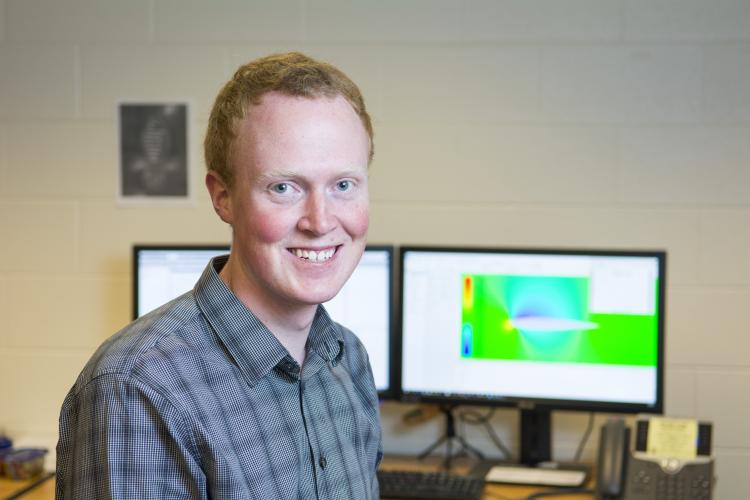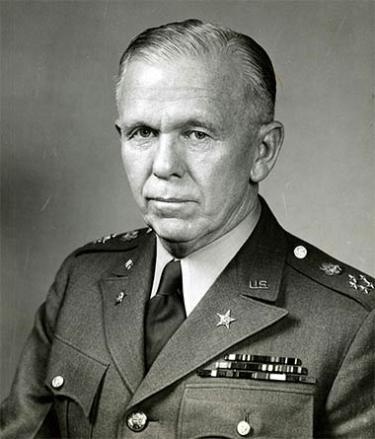For as long as he can remember, Matthew Hurst has viewed the world around him in terms of angles and calculations, eyeing everything from the paper airplanes he crafted as a child to the spacecraft he still dreams of flying with one question in mind: How can mathematics be used to make it work better?

Matthew Hurst's computational modeling research aims to make the early stages of air and spacecraft design more efficient and less expensive.
Ìı
âIf you think about it, just about everything that requires any engineering starts with a mathematical model to make sure it will actually work in the real world,â explains Hurst, 21, a senior double-majoring in aerospace engineering and applied math. âItâs about taking a real-world problem, whether itâs designing a chair that wonât collapse or improving the wing of an aircraft, and turning it into a set of equations that lead to a solution. The applications are endless and really exciting.â
Hurstâs rare combination of outstanding math, engineering and research skills this week earned him the covetedÌı, a two-year full-ride grant to pursue an advanced degree at a United Kingdom institution of his choice.
Enacted in 1953 by the British Parliament and named after former U.S. Secretary of State George C. Marshall, the scholarship was developed as a thank-you for U.S. aid in rebuilding Europe after World War II. It is offered to 30 to 40 students annually out of 1,000 applicants and targeted toward âintellectually distinguished young Americans â their countryâs future leaders.â
Hurstâs mentor Alireza Doostan, a ÃÛÌÇÖ±²¥ Boulder Rome Associate Professor of Aerospace Engineering, says Hurst fits the bill.
âHe is a great engineer with outstanding interest in and familiarity with applied mathematics that is really unique. Heâs on the trajectory to become a very successful researcher,â says Doostan.
A born engineer
Growing up in Lafayette, ÃÛÌÇÖ±²¥, Hurst spent hours in his room at age 7, folding paper into elaborate airplanes, testing them, re-folding them to improve aerodynamics and testing them again.
By high school, he was putting his eye for design to a more practical use, traveling to Mexico each summer with a volunteer group to build homes for residents.
He chose ÃÛÌÇÖ±²¥ Boulder for its Engineering Honors program and undergraduate aerospace program (Ìıamong public universities by U.S. News and World Report).
âGiven the prestige of our program, Matthewâs 4.0 GPA is a notable feat,â wrote ÃÛÌÇÖ±²¥ Boulder Chancellor Philip DiStefano in Hurstâs recommendation for the scholarship.

U.S. Secretary of State George C. Marshall
Ìı
Sophomore year, Hurst interned with Lockheed Martin at Schriever Air Force Base in ÃÛÌÇÖ±²¥ Springs, working on flight operations of the Global Positioning System satellite constellation, with the goal of boosting accuracy and reliability.
That same year, he competed in the Mathematical Contest in Modeling, a grueling international competition in which teams are given a problem and 96 sleepless hours to come up with a solution. Out of 2,000 teams, Hurstâs was among five winners.
Today, Hurst is working with Dooston and ÃÛÌÇÖ±²¥ Boulder Aerospace Engineering Assistant Professor John Evans to develop novel computational tools that could someday hasten the process by which engineers arrive at the ideal design for air and spacecraft.
Modern-day modeling
Unlike the early designers of the 1900s, or the younger Hurst crafting airplanes in his bedroom, designers today can test their ideas on, say, the best design for an airfoil (the curved surface of an aircraft wing) with computational models and simulations. âBut it can require a lot of computers, a lot of time and a lot of money to get one answer to one problem,â says Hurst.
Heâs developing âmulti-fidelity modelingâ tools that will enable designers to more efficiently run multiple simulations factoring in different airspeeds and rotations, airfoil shapes, lengths, widths and other variables.
âMy work, bottom-line, can help improve the efficiency of these design methods so engineers donât have to wait months and months and spend lots of money to get results,â says Hurst, who expects to publish a paper soon.
He plans to use his scholarship to earn a masterâs degree in mathematical modeling at the University College of London, and a second masterâs in applied mathematics at the University of Cambridge.
Ultimately, heâd like to help design a Mars-bound spacecraft. And when itâs ready, heâd like to climb aboard.
âIâve always wanted to be an astronaut,â he says. âI still do.â
For more information on this or other scholarships, contact Deborah Viles atÌıtopscholarships@colorado.edu.
